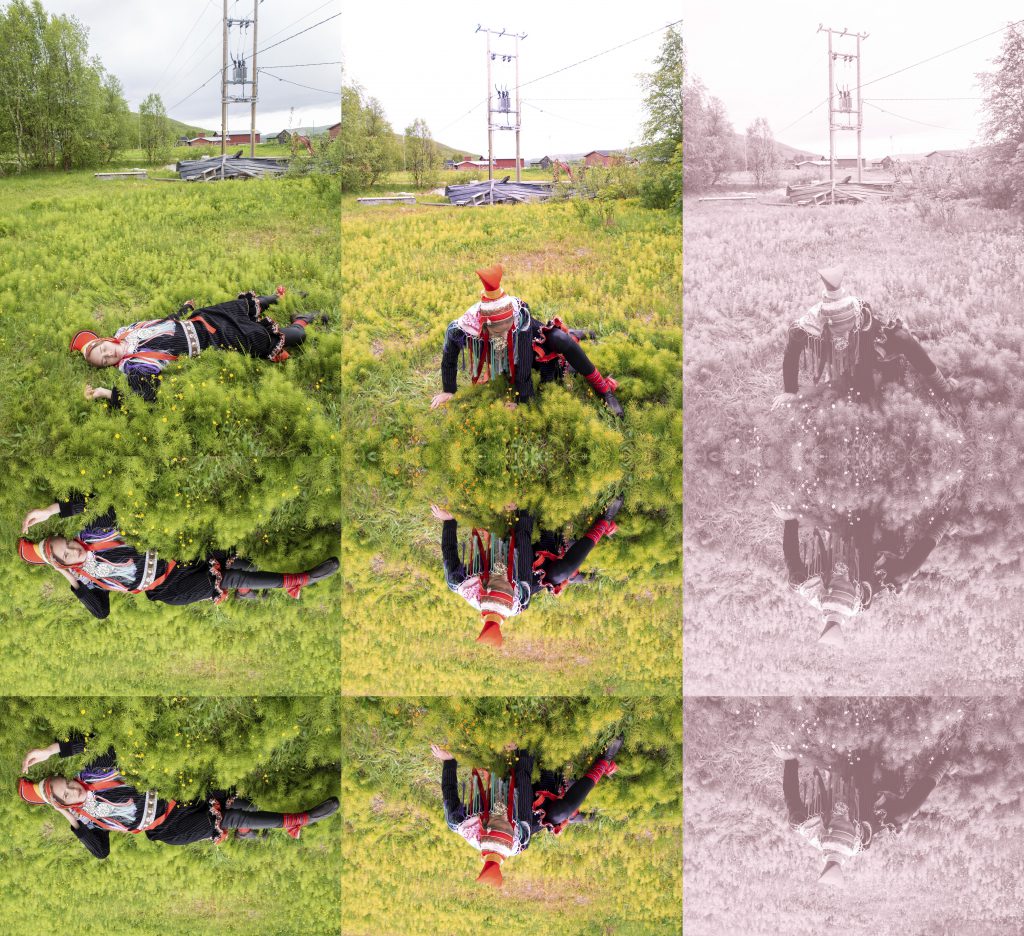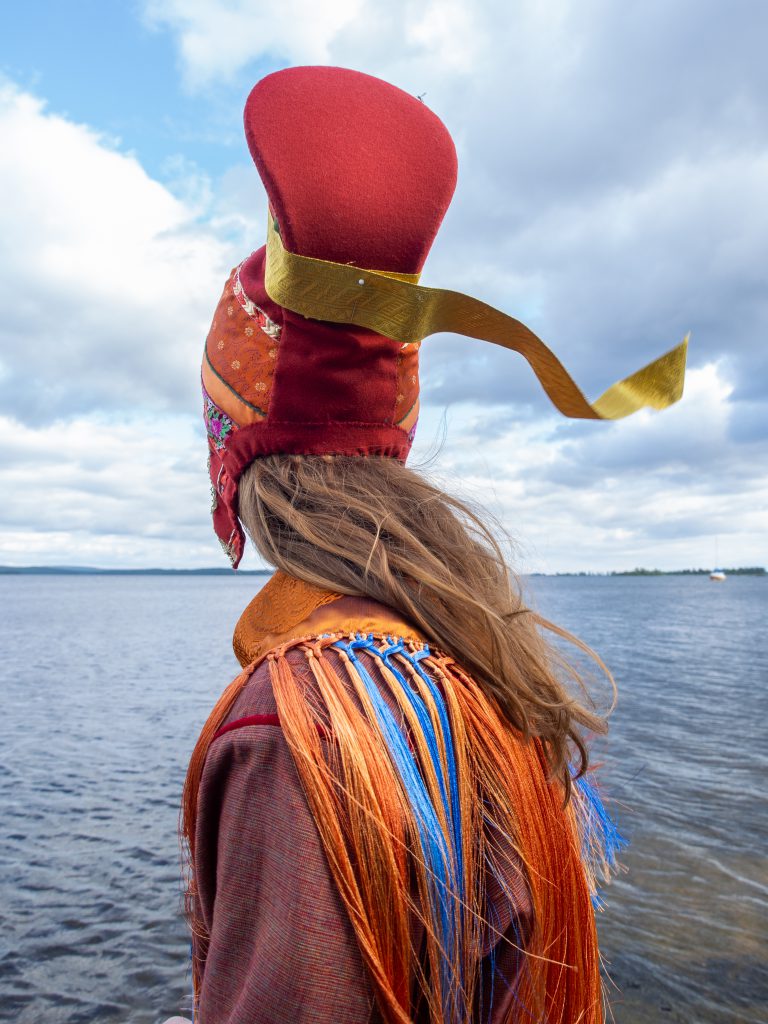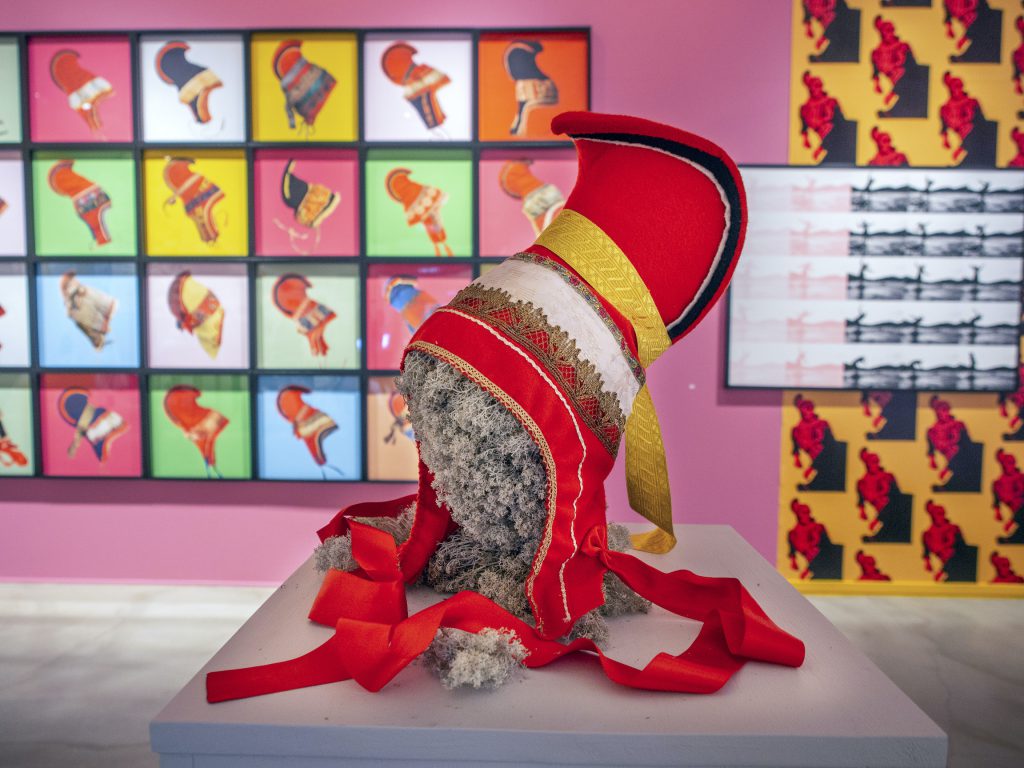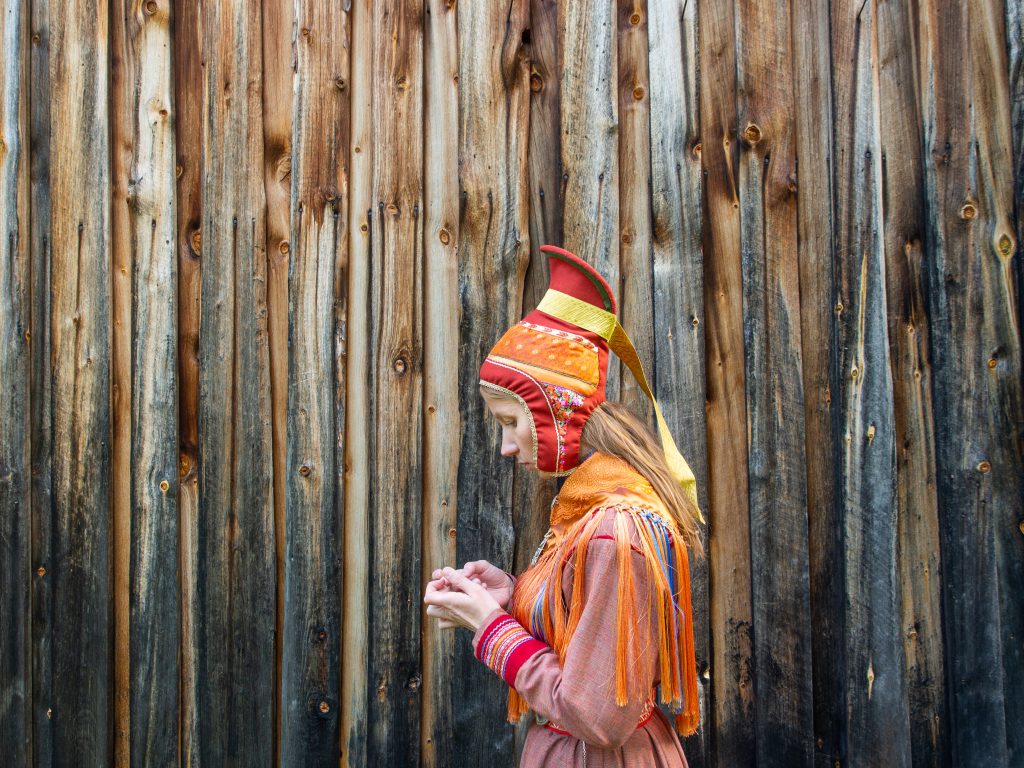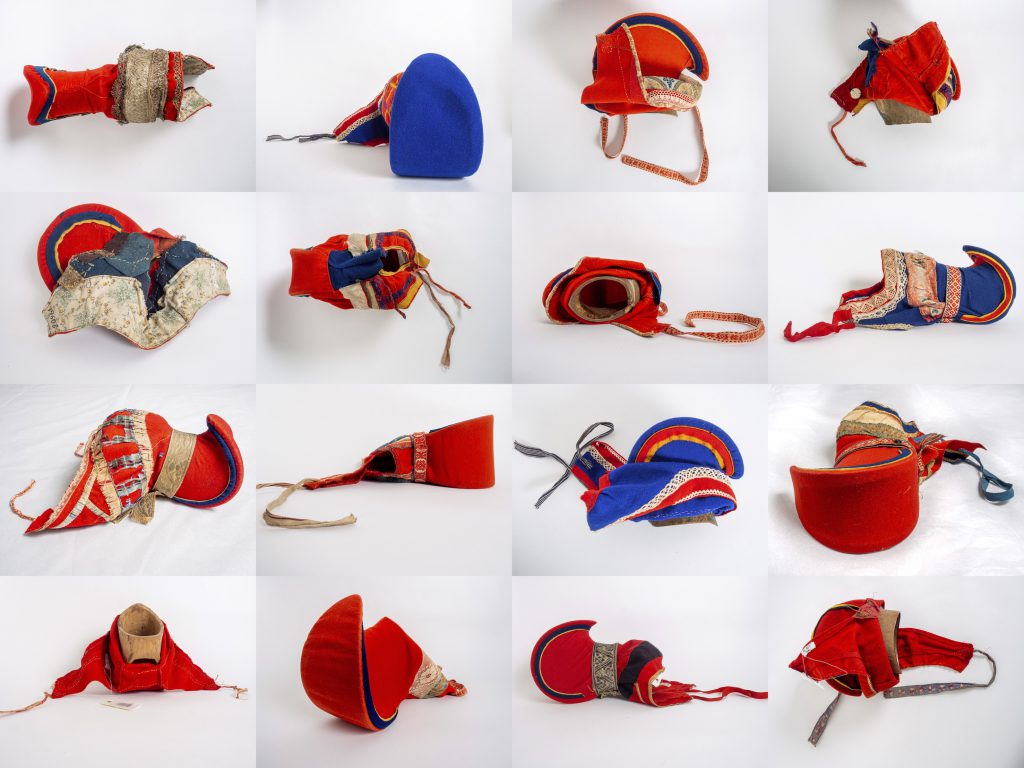What might a process of “rematriation” in Sámi society look like? According to Sámi political scientist Jovnna Jon Ánne Kirstte Rávdná1/Rauna Kuokkanen, rematriation means going back and bringing in the central principles of previously existing indigenous systems where women had a form of equality with men, characterized by symmetrical complementarity of domains, roles, and tasks as well as decision making and authority.2 What if we were to take an important yet suppressed form of Sámi duodji, or craft, and trace its fate under colonial suppression and its persistence as a manifestation of the inheritance of traditional Sámi female power?
One such type of artefact is the ládjogahpir, a crown-like headgear that was used by Indigenous Sámi3 women from the middle part of eighteenth century until the end of nineteenth century in the Northern parts of the Sámi area in Norway and Finland. Spectacular and ornate, the lower part of the hat is a tight bonnet decorated with colorful fabric or ribbons, while a fierra, a high, curved wooden protrusion, adorns the back of the head. Ládjogahpirs can be seen as a broken tradition of Sámi duodji and for the most part can be found in historical stories and ethnographic museums; today only a narrative of the hat remains.
In this narrative, the distinctive wooden part, the fierra, was related to the devil and its story is one of the religious colonization of the Sámi population. Sometimes, the ládjoghpir was condemned by the priests, but most often its suppression is connected to the Laestadian movement, one of the Pietistic movements in the 1840s directed specifically towards the Sámi population. Laestadius (1800–1861) was a Sámi himself and a vicar of Gárásavvon, in the heart of the Sámi region. The movement held that people should come to church in mourning and wear simple clothing. Instead of the stunning ládjoghpir, Sámi women were instead instructed to look more humble by donning flat and low bonnet-like hats, because the devil was in the ládjoghpir’s fierra.4
According to Sámi social scientist Vilgon Biret Ánne Iŋger Ánne Sanna/Sanna Valkonen,5 Laestadianism can be seen as a colonization of the mind and body. In the parlance of postcolonial research, “colonization of mind” explains the process by which an individual absorbs foreign (colonial) conceptions of itself and its traditions as constructed by foreign power structures and ways of thinking.6 The colonization of the body, on the other hand, had a big influence on modes of dress and on women’s concepts of themselves and the skills they had. Furthermore, women were subjected to a different kind of control which influenced female sexuality, as the Laestadian movement also emphasized concepts of female piety and modesty in addition to common Christian dualistic notions of women as either good or evil.7
How does the existence of the ládjogahpir, including its eventual abandonment, connect with Sámi women’s social role and status? And how does this relate to consecutive changes in women’s position in Sámi society and in Sámi worldviews, particularly those instigated from the impact of Laestadianism and the inner colonization it generated? Kuokkanen has written that the contemporary Sámi community suffers from the consequences of cultural alienation and that it would benefit from a more matriarchal world view. Sámi women have historically enjoyed some form of equality with men, as there was a symmetry and complementarity of roles in the life circuit. This was also reflected in some kind of economic independence and equal footing in inheritance, for example. But colonialism and the processes of assimilation induced profound changes in gender roles. Both Kuokkanen and Mi´kmaq researcher Bonita Lawrence have identified gender discrimination as a constituent part of the colonization of indigenous communities.8
The ládjogahpir represents the ancient cosmology and a solid social and equal relation between the genders. It stands for a society that prospered before colonial gender violence brought heteropatriarchy and western epistemologies to Sápmi. The narrative of the devil’s horn can be interpreted as a metaphor for demonizing the Sámi female guardian spirits, the foundation of Sámi cosmology and society. When European patriarchy was established in Sápmi as an integral part of the colonization process, Sámi women were displaced from their original positions of respect. The introduction of the patriarchal system introduced new power structures into gender roles, dividing the sacred from the profane, and human beings from nature. Patriarchalism brought a new world order and hierarchies that generated developments towards an unbalanced society and violence towards living beings.
According to Kuokkanen, the role of Sámi Goddesses, like Sámi women, have been neglected in research due to common patriarchal bias of ethnographic interpretations of cultural practices.9 Sámi Goddesses Máttáráhkká and her daughters Sáráhkká, Uksáhkká, and Juoksáhkká can be seen as the very foundation of the Sami cosmic order, as they provide life for human beings and domestic animals, like reindeer. They also symbolize the community’s connection to the land. They create new life, mediate the soul, and create the body. They assist with menstruation, childbirth, and the protection of children.10 Even Laestadius, like other connoisseurs of Sámi cosmology, recognized the significance of female deities and their central role.11 The relevance of Goddesses can be seen, for example, in some place names that have the affix “áhkká.”12 The powerful Goddess creator Sáráhkká was meaningful and worshipped by all genders, probably because she was the protector of birth and therefore the enabler of life.13 Her name originates from the word sáret, to create. The Goddesses Sáráhkká, Uksáhkká, and Juoksáhkká dwelled in the terrain of the Sámi hut, goahti, where each of them had a certain place. They received gifts as spirit was poured into the area where they dwelled.14
The Sámi people were Christianized from the thirteenth century onwards, in some areas more effectively depending on attitudes, location, topography, livelihood, but also location. Especially in the Sámi area where the Northsámi language was spoken, the Laestadian movement became dominant and had a stronger influence for conversion from 1850 and onwards.15 Until then, the old cosmology and Christian worldview lived side by side. Another factor here is that in the Sámi community, men were responsible for contacts with outsiders such as merchants and priests. Therefore, the male religion and Gods vanished more quickly because females kept the old cosmology alive in the open for a longer time, simply due to the fact that the missionaries had no contact with the woman.16 Maybe ládjogahpirs can be considered a sign of Sámi cosmology that remained despite Christianity, even in the face of much cultural destruction.
Sámi author Lemet Sire Rauni/Rauni Magga Lukkari has said: “Duodji is a message which opens to those who can read it.” The Sámi craft, duodji contains the knowledge, art, and skills of the previous generations, but also a worldview and the relationship to earth. When you search materials for duodji you negotiate what you can take from nature. This means you have a reciprocal relationship with earth, gulahallat eatnamiin.17 Some elements of this symbolic communication that duodji contains have been silenced through Christianity and colonialism. Still, duodji retain a lot of spiritual aspects that are based on the Sámi world view.18 We argue that the ládjogahpir, like some other Sámi female hats, was a fertility symbol, a symbol of the female power to reproduce,19 a symbol of Sáráhkká.20 It was used because the female still had the possibility to manifest the Sámi cosmology in clothing and accessories. The change in the Sámi worldview and spirituality from female divinities Uksáhkká, Juoksáhkká, and Sáráhkká to Christianity and the masculine trinity of God, the Father, the Son, and the Holy Spirit relegated the old symbol to the shameful or even forbidden.
Sámi folklore contains narratives of ancestors with treasures hidden in nature. In the North Sámi language, mother is eadni and earth is eana. The two words share etymologies and semantics. Like many other Indigenous peoples, the Sámi consider the earth to be sacred and feminine—their mother. In the Sámi religion, Goddesses dwell in the earth underneath the árran, the fireplace of the goahti, the Sámi hut, suggesting that the treasure is the earth itself. Knowledge and wisdom reside in our mother earth and it is our obligation to listen to her. If we do listen, she will tell us how to walk our paths, as she has told our ancestors before us. When we embrace gender equality and the larger biocultural reality, we will also understand that the earth as a female being must be respected. Sacredness is in all genders, but we live in a world where the balance between them has been disturbed. We need to recover this balance and achieve reciprocity with all beings. Violence towards women is synonymous with violence towards—and the plundering of—the earth.
Much of the original meaning of the ládjogahpir is lost, as are large parts of the overall history of Sámi women. However, as the hat is being made and worn again, it will embrace and house new meanings. The ládjogahpir today may be regarded as a symbol of a new decolonial feminism, forwarding a message from our foremothers that live beside us. There is something utterly special and powerful when Sámi women who wear this hat today. The revitalization of the ládjogahpir is a step towards decolonization. The ládjogahpir, like other Sámi artefacts, carries the traditional knowledge of the ancestors with it, forwarding messages across generations. For those who can read their language, the artefacts embody the encoded knowledge of their cultural heritage. Cultural artefacts are agents that can provide security, a sense of belonging, and even heal or alleviate colonial wounds. The spiritual meanings embodied in the symbolism and the aesthetics of the ládjogahpir, the rehabilitation and revitalization of the hat itself, the knowledge engaged in both making and wearing it, and the emotions generated in the involvement with the hat all signify rematriation. As an affirmative manifestation of the power and vitality of Sámi women, the revival of the ládjogahpir is a re-socialization of cultural artefacts in a social and communal context, aspects not attained in the processes of repatriation. Cultural artefacts can act as mediators and enablers in the decolonization processes in Sápmi.
Our project Ládjogahpir—The Foremothers’ Hat of Pride investigates the complex history and legacy of the ládjogahpir and its present-day renaissance.21 In our work, we combine historical and archaeological research; social activism and craftivism, including the revitalizing of duodji traditions; and artistic practices. We write and visualize the dramatic events surrounding the hat’s history, including its demise, and its spectacular reappearance. Our research has led us to archives, collections, and libraries across Europe, resulting in a remarkable inventory and visual history of all known ládjogahpirs. Our project has also involved organizing encounters with Sámi women who have shared their duodji skills, values, ideas, and dreams, participating in the ládjogahpir revival. Our research is a contribution to Sámi women as we study the colonial influence on their history, spirituality, and philosophy through a story of one object, the ládjogahpir. Duodji, working with repatriated artefacts, and rematriation are sensible means with which to initiate decolonial practices in Sámi society. Jovsset Ánne Inggá Gunvor/Jovnna Ovllá Olave Gunvor/Gunvor Guttorm write that the body remembers movements and when you move while gathering or working with materials, its memories are awakened.22
Recently, the concept of intergenerational trauma has been discussed. What if the mind and the body remember intergenerationally? If we carry our ancestors’ knowledge in our daily routines and physical making, would the collective subconscious of a group of people who knows and understands duodji enable them to interpret the knowledge embodied in duodji items such as the ládjogahpir, and bring the messages from our ancestral mothers back to present-day Sámi society? For real rematriation to take place, we need the dozens of ládjogahpirs and other Sámi belongings stored in museum collections in the Nordic countries and in Europe to be returned to eana eannážan, to our mother earth. Only in their own cultural context can they be truly helpful in the processes of remembering, decolonizing, and healing. We need to bring these powerful belongings back home.
